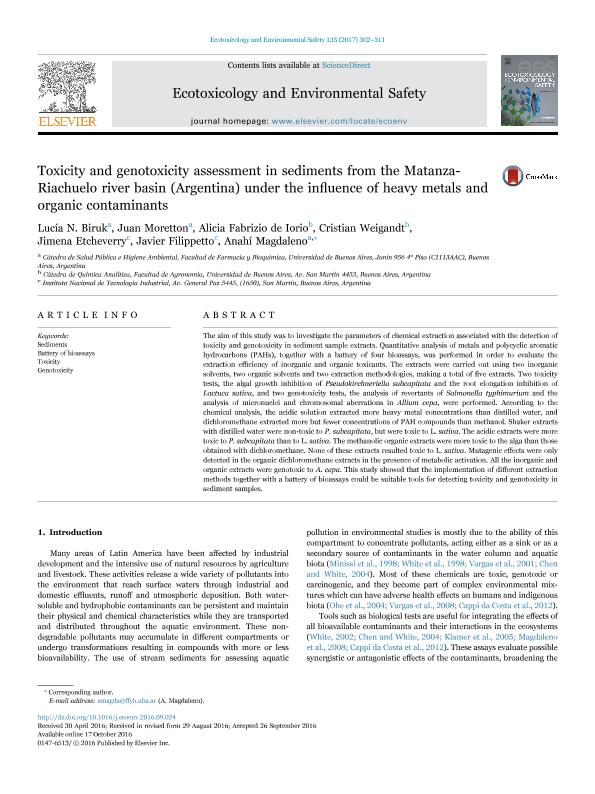Artículo
Toxicity and genotoxicity assessment in sediments from the Matanza-Riachuelo river basin (Argentina) under the influence of heavy metals and organic contaminants
Biruk, Lucia Nadia ; Moretton, Juan; Fabrizio de Iorio, Alicia Rosa; Weigandt, Cristian; Etcheverry, Jimena; Filippetto, Javier; Magdaleno, Anahí
; Moretton, Juan; Fabrizio de Iorio, Alicia Rosa; Weigandt, Cristian; Etcheverry, Jimena; Filippetto, Javier; Magdaleno, Anahí
 ; Moretton, Juan; Fabrizio de Iorio, Alicia Rosa; Weigandt, Cristian; Etcheverry, Jimena; Filippetto, Javier; Magdaleno, Anahí
; Moretton, Juan; Fabrizio de Iorio, Alicia Rosa; Weigandt, Cristian; Etcheverry, Jimena; Filippetto, Javier; Magdaleno, Anahí
Fecha de publicación:
01/2017
Editorial:
Academic Press Inc Elsevier Science
Revista:
Ecotoxicology and Environmental Safety
ISSN:
0147-6513
Idioma:
Inglés
Tipo de recurso:
Artículo publicado
Clasificación temática:
Resumen
The aim of this study was to investigate the parameters of chemical extraction associated with the detection of toxicity and genotoxicity in sediment sample extracts. Quantitative analysis of metals and polycyclic aromatic hydrocarbons (PAHs), together with a battery of four bioassays, was performed in order to evaluate the extraction efficiency of inorganic and organic toxicants. The extracts were carried out using two inorganic solvents, two organic solvents and two extraction methodologies, making a total of five extracts. Two toxicity tests, the algal growth inhibition of Pseudokirchneriella subcapitata and the root elongation inhibition of Lactuca sativa, and two genotoxicity tests, the analysis of revertants of Salmonella typhimurium and the analysis of micronuclei and chromosomal aberrations in Allium cepa, were performed. According to the chemical analysis, the acidic solution extracted more heavy metal concentrations than distilled water, and dichloromethane extracted more but fewer concentrations of PAH compounds than methanol. Shaker extracts with distilled water were non-toxic to P. subcapitata, but were toxic to L. sativa. The acidic extracts were more toxic to P. subcapitata than to L. sativa. The methanolic organic extracts were more toxic to the alga than those obtained with dichloromethane. None of these extracts resulted toxic to L. sativa. Mutagenic effects were only detected in the organic dichloromethane extracts in the presence of metabolic activation. All the inorganic and organic extracts were genotoxic to A. cepa. This study showed that the implementation of different extraction methods together with a battery of bioassays could be suitable tools for detecting toxicity and genotoxicity in sediment samples.
Palabras clave:
Battery of Bioassays
,
Genotoxicity
,
Sediments
,
Toxicity
Archivos asociados
Licencia
Identificadores
Colecciones
Articulos(IADIZA)
Articulos de INST. ARG DE INVEST. DE LAS ZONAS ARIDAS
Articulos de INST. ARG DE INVEST. DE LAS ZONAS ARIDAS
Citación
Biruk, Lucia Nadia; Moretton, Juan; Fabrizio de Iorio, Alicia Rosa; Weigandt, Cristian; Etcheverry, Jimena; et al.; Toxicity and genotoxicity assessment in sediments from the Matanza-Riachuelo river basin (Argentina) under the influence of heavy metals and organic contaminants; Academic Press Inc Elsevier Science; Ecotoxicology and Environmental Safety; 135; 1-2017; 302-311
Compartir
Altmétricas



